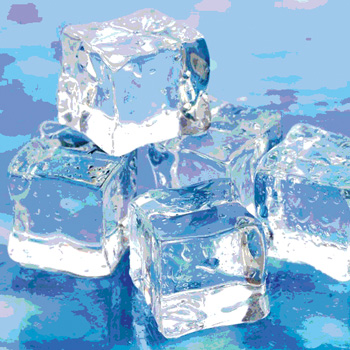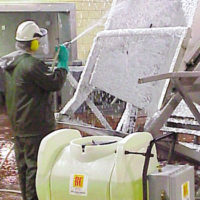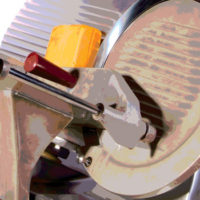The Sanitation of Ice-Making Equipment

Sixty years ago, an article on the sanitation of crushed ice was published in the Journal of the American Medical Association.[1] The authors commented that an investigation of crushed ice revealed heavy contamination with coliform organisms. They opined that the contaminants can be introduced into crushed ice in many ways, chiefly by dust from the floors of freezing rooms, trucks and restaurants as well as by reusing soiled containers and through human hand contact. Of these, it was no small wonder that handling during dispensing was found to be the most prolific source.
It took another 15 years for the U.S. Centers for Disease Control and Prevention to issue a publication in which epidemiologists traced several outbreaks of gastrointestinal illness—including noroviruses—to the use of contaminated ice, although many of these were in hospital settings (see “Safe Ice: The Cold, Hard Facts”). Nonetheless, ice is no different from food or water when viewed as a comestible. However, there are differences between ice and potentially hazardous foods. First, even though the temperature of ice is well within the “safety zone,” ice machines are prone to microbial contamination. Even clean, potable water can become contaminated ice in ways that may not be readily apparent. Secondly, using a classical Hazard Analysis and Critical Control Points approach in evaluating the use of ice in the average retail food establishment will reveal that ice manufacturing, storage, distribution and handling is quite complex because of its almost universal use in preparation, service and as a food. The analysis will reveal Critical Control Points we would never imagine when dealing with meat or poultry. Additionally, applying a detailed plan review to the use and traffic of ice in a typical restaurant, the patterns that are revealed would make any sanitarian cringe, particularly those that lead to multiple and inappropriate handling practices. Finally, because ice is so common and its use is constant and universal, we tend to view ice much the same way we do water. The assumption is that both water and ice are clean, with the latter merely being an extension of the tap.
Controlling Contamination
Since the recognition of ice as a source of microbial contamination, science has given us a better understanding of biofilm production and its control. Biofilms are a collection of microorganisms, mainly bacteria, growing together in a matrix of polymers secreted by the microorganisms. The associated slime formation is mold or fungus that accumulates from bacterial growth on surfaces constantly exposed to clinging water drops and warm temperatures. The biofilm may cause objectionable flavors and odors in ice. Once well-developed biofilms establish themselves on surfaces, cleaning and sanitation become much more difficult. Biofilms have a shielding effect on the bacterial cells that live within them. It is well known that normal cleaning and sanitizing methods may not control or eliminate biofilms, but rather they must be physically removed or prevented from forming on surfaces. For instance, Listeria can be 1,000 times harder to eliminate if it is living in a protective biofilm and can be a continual source of pathogenic and spoilage organisms if not completely removed.
Manufacturers of ice machines recognize the biofilm phenomenon and have engineered units that minimize its formation and facilitate its removal. Clean ice, clean ice storage bins and sanitary handling practices are the key to improving the product quality.
The current and traditional methods of sanitation have come under scrutiny by the manufacturers of ice machines and providers of standards for these units, such as NSF International (NSF/ANSI 12–2012: Automatic Ice Making Equipment). Because of manufacturers’ initiatives, users are given more options for ice machine configurations, capacities and methods of delivery to minimize the inherent problems of the earlier units. These enhancements include automated cleaning cycles, light indicators when the unit needs cleaning and servicing, sensors that detect scale buildup and construction with materials that facilitate ease of cleaning and confer a degree of bacteriostasis on its wettable parts. In addition, manufacturers report that 70 percent of ice machine performance problems are associated with the water supply, through poor water quality, slow fill or insufficient water supply, and have acted accordingly to cope with these problems as well. All manufacturers now provide customers with valuable information on selection and operations.
The Regulatory Environment
The regulatory community has become more aware of the potential for contamination and is now asking questions as part of the inspection process regarding frequency and methods of routine sanitation, and operations and maintenance in accordance with manufacturers’ recommendations. When ice machines are inspected, it is clear that many are not cleaned and sanitized very often, if ever. Mold and slime buildup inside them is quite visible. Numerous studies show that dirty, contaminated ice is more common than people think.
As the ice-making machine has changed, so have the laws governing ice used for human consumption. Consider the following. The U.S. Food and Drug Administration Food Code is the standard. Chapter 1 part 1-201.10 defines ice as food. This mandates ice to the same handling and cleanliness standards as everything else in retail food, including manufacturing equipment. Ice itself falls under 40 C.F.R. 141 governing drinking water purity. Ice machine cleaning is governed by Food Law 2009 Chapter 4 part 602.11 section (E) item (4a and b), which states that the machines must be cleaned “at a frequency specified by the manufacturer,” which in most instances ranges from two to four times per year, or “at a frequency necessary to preclude accumulation of soil or mold.” Ice machine sanitizing is governed by Chapter 4 part 702.11, which states that the ice contact surfaces must be sanitized after each cleaning. Annex 7 Form 2A section 5 states: Federal law provides under the Criminal Fine Enforcement Act of 1984 for a fine up to $100,000 for a misdemeanor by a corporation or individual not resulting in death and, for misdemeanors resulting in death, a fine of up to $250,000 for individuals and $500,000 for corporations. The bottom line is that cleaning and sanitizing the ice machine on a regular basis is required by law, whereas operations and maintenance in accordance with manufacturers’ recommendations extend the optimal life of the unit and help minimize risk of contamination.
There are several common-sense guidelines that should be followed to avoid liability problems associated with contaminated ice in addition to adhering to manufacturers’ recommendations on cleaning and maintenance. Not mentioned in most manufacturers’ instructions are the following common-sense issues:
The sanitary handling of ice. All workers who handle ice should be taught the following precautions:
• Wash hands before obtaining ice.
• Hold the ice scoop by the handle and do not touch other parts of the scoop.
• Do not handle the ice with hands.
• Do not return unused ice to ice storage chest or ice machine.
The sanitation of equipment. The following practices should be part of the facility’s operations:
• Keep the access doors to ice storage chests and ice machines closed except when removing ice.
• Ice scoops should be smooth and protected against contact with contaminated surfaces such as floors, access door handles, service carts and non-food contact surfaces, to cite a few examples. Scoops should be kept on an uncovered stainless steel, impervious plastic or fiberglass tray when not in use. The tray and scoop should be cleaned daily in the kitchen scullery dishwasher.
• Remove all extraneous equipment and items from around or in the ice storage chests and ice-making machines, and if possible, limit access to them.
• Clean the ice storage chests on preferably a weekly schedule, but no less than monthly.
• Consider routine microbiologic sampling of the ice and ice contact surfaces of the machine. Although this is not necessary, it can provide guidance on cleaning frequency and methods.
As a final note, there is an excellent guideline on procedures for cleaning contaminated ice machines developed by the U.S. Army Center for Health Promotion and Preventive Medicine, Food Sanitation and Environmental Health, DEHE. It’s available at phc.amedd.army.mil/PHC%20Resource%20Library/57-019-1205ProceduresforCleaningIceMachinesfs.pdf.
 Forensic sanitarian Robert W. Powitz, Ph.D., M.P.H., R.S., C.F.S.P., is principal consultant and technical director of Old Saybrook, CT–based R.W. Powitz & Associates, a professional corporation of forensic sanitarians who specialize in environmental and public health litigation support services to law firms, insurance companies, governmental agencies and industry. For more than 12 years, he was the director of environmental health and safety for Wayne State University in Detroit, MI, where he continues to hold the academic rank of adjunct professor in the College of Engineering. He also served as director of biological safety and environment for the U.S. Department of Agriculture at the Plum Island Animal Disease Center at Orient Point, NY. Among his honors, Powitz has received the NSF/NEHA Walter F. Snyder Award for achievement in attaining environmental quality and the AAS Davis Calvin Wagner Award for excellence as a sanitarian and advancing public health practice. He is the first to hold the title of Diplomate Laureate in the American Academy of Sanitarians and is a diplomate in the American Academy of Certified Consultants and Experts and with the American Board of Forensic Engineering and Technology. Dr. Powitz can be reached at Powitz@sanitarian.com or through his website at www.sanitarian.com.
Forensic sanitarian Robert W. Powitz, Ph.D., M.P.H., R.S., C.F.S.P., is principal consultant and technical director of Old Saybrook, CT–based R.W. Powitz & Associates, a professional corporation of forensic sanitarians who specialize in environmental and public health litigation support services to law firms, insurance companies, governmental agencies and industry. For more than 12 years, he was the director of environmental health and safety for Wayne State University in Detroit, MI, where he continues to hold the academic rank of adjunct professor in the College of Engineering. He also served as director of biological safety and environment for the U.S. Department of Agriculture at the Plum Island Animal Disease Center at Orient Point, NY. Among his honors, Powitz has received the NSF/NEHA Walter F. Snyder Award for achievement in attaining environmental quality and the AAS Davis Calvin Wagner Award for excellence as a sanitarian and advancing public health practice. He is the first to hold the title of Diplomate Laureate in the American Academy of Sanitarians and is a diplomate in the American Academy of Certified Consultants and Experts and with the American Board of Forensic Engineering and Technology. Dr. Powitz can be reached at Powitz@sanitarian.com or through his website at www.sanitarian.com.
Reference
1. Sanitation of crushed ice. 1953. JAMA 153(12):1101.
Safe Ice: The Cold, Hard Facts
As all frequent travelers know, it’s best to avoid drinking beverages that contain ice when in less-developed countries. The ice could be made from contaminated water, and that can make you sick. But local ice made with fresh water should always be safe, right?
In fact, ice can and does cause foodborne illness in developed countries such as the United States. Some of the illnesses are caused by bacteria and some are caused by viruses. Many outbreaks have been linked to the presence of norovirus in the ice. In some cases, the norovirus came from contaminated well water that had been used to make the ice, in other cases, from poor handling practices. Other outbreaks associated with ice consumption have been caused by Salmonella, hepatitis A and Escherichia coli O157:H7.
There is no excuse for using contaminated water to make ice; freezing water does not kill bacteria, nor does it inactivate viruses. Viral particles can survive undamaged in ice for lengthy periods, and just a few viral particles can cause illness. In fact, norovirus has been described as the most infectious agent ever studied in humans. It accounts for more than one-half of all foodborne illnesses. Last year, over 11,000 children in Europe were sickened by norovirus that was in a shipment of frozen strawberries from China. Norovirus usually finds its way into food, including ice, due to poor handling practices. Norovirus originates in human fecal matter, and improperly washed hands are thought to be the main cause of contamination. If you have ever seen a bar person drag a glass through an ice tub with his bare hands or watched an employee drop the ice scoop back into an ice machine bin with the handle coming into contact with the ice, you have seen a norovirus outbreak waiting to happen.
If ice is handled with care, many problems can be prevented. However, the ice itself must be safe to begin with. Most commercial quantities of ice are made using ice machines or ice makers that are permanently connected to a water supply. It is the responsibility of the ice machine operator to ensure that the water supply is safe. If the water comes from a well on the premises, the water must be tested frequently. If it is connected to a municipal water supply, remember that if the authorities notify you of any problem with the water, then the ice from the ice machine may not be safe.
Cleaning and sanitizing the ice machine is another very important step to provide safe ice. Ice machines should be cleaned and sanitized using the chemical products supplied by the machine manufacturer at least once per month. Machines on some sites will require even more frequent cleaning, especially those in environments with dusty air, high humidity or high airborne microbiological load. Bakeries, microbreweries, sandwich outlets with on-site baking and bars with draft beer on tap can have high concentrations of airborne yeast, and this can cause microbiological buildup to happen very quickly inside ice machines in these environments.
Needless to say, cleaning an ice machine can be a difficult and expensive exercise. In a large commercial kitchen, it is often performed by outside contractors, and these contracts can be the first to be downsized when cost-cutting measures are called for. In addition, deep cleaning and servicing involve dismantling the equipment, which can be difficult to do without disrupting kitchen service.
Some ice machines are better designed than others for ease of cleaning. Nooks and crannies, joints and deeply squared internal corners are difficult to clean because cloths and brushes do not penetrate easily. A well-designed ice machine will have rounded internal corners on its ice chutes and ice bins, smooth internal surfaces and an easy-to-access, ice-making chamber. External surfaces should be impervious, corrosion resistant and designed so that food scraps, grime and dust can easily be wiped off. Water contact and ice contact surfaces inside the machine should be made only from food-safe materials to prevent
migration of unwanted chemicals into the ice.
Ice machine sanitation has recently received a boost from new technology that can aid in the prevention of biofilm formation. Many new models of ice makers include a built-in device that uses ultraviolet (UV) light technology to convert air and water vapor from inside the ice machine into powerful oxidants that circulate through the machine and destroy microorganisms.
Retrofit systems using a similar UV disinfection technology are also on the market and can be installed into all makes and models of commercial ice machine equipment. Both the factory-installed and retrofit systems require only a simple annual UV lamp replacement to maintain effectiveness. Users of these devices
report significantly cleaner ice-making chambers, with less mold and slime.
 Karen Constable is the certification manager of HACCP International.
Karen Constable is the certification manager of HACCP International.
Looking for a reprint of this article?
From high-res PDFs to custom plaques, order your copy today!








